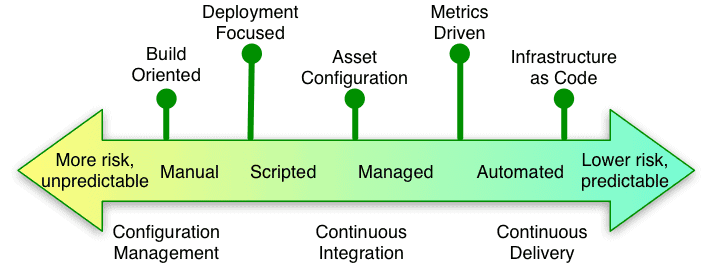Practices such as Continuous Integration and Continuous Delivery should not be confused as point goals or destinations. They are better thought of as a cluster of capabilities on a continuum of applied skills and best practices that reduce risk and increase the predictability and value creation.
The graphic below provides an encapsulated visual representation of this continuum. At a macro level, moving from left to right decreases risk, enhances the ability to create value, and improves predictability as well as cycle time and quality.
Another way of thinking about these attributes collectively is in terms of agility and flexibility – or the ability to get the right product features into customers’ hands quickly and reliably.

Looking inside the continuum, there is a progression of process competency from a risky, labor intensive, manual mode all the way to a predictable and reliable mode of automation. This applies whether one is looking just at Continuous Integration or any mix of Continuous Delivery capabilities, up to and including automatic production deployment.
This also applies as one wants to move between modalities, say, from Continuous Integration to Continuous Delivery. Here we see cultural and process orientation built into the progression as capability increases to the right. A team with basic configuration management practices in place that is working on adopting Continuous Integration for example, is going to be more concerned with automating and making repeatable the product build (Build Oriented) than with optimizing cycle time (Metrics Driven) of full product deployments. As the team progresses, the focal points will advance as well.
In fact, the progression between modalities from basic configuration management, through Continuous Integration to Continuous Delivery is a chain of prerequisites to each other. One cannot have Continuous Delivery without first having implemented Continuous Integration.
Regardless of which modality is your current state, and which is your target state, the continuum is a useful construct to think about what capabilities are in place, which processes are there, what the current cultural mindset is, and then plan the changes needed to advance along the continuum.
Most importantly, remember to frame the target state as a modality and not the goal. The goal is to increase predictability and quality, reduce cycle time, and eliminate risk.
To learn more about how Ten Mile Square can help you move to the right on the Continuous Delivery Continuum, email us at info@tenmilesquare.com
Comments are closed.